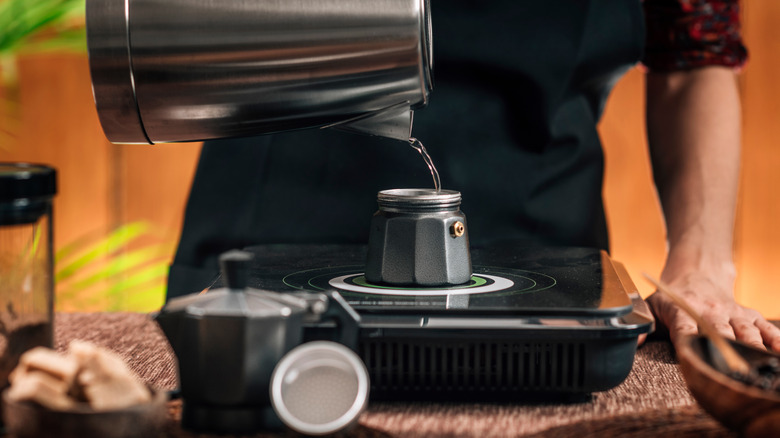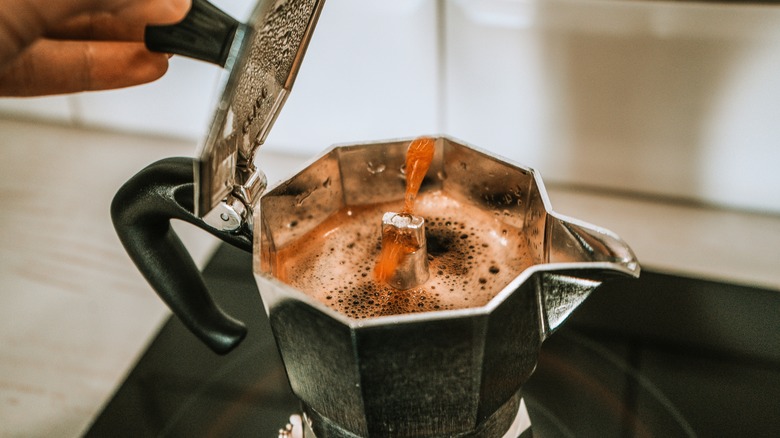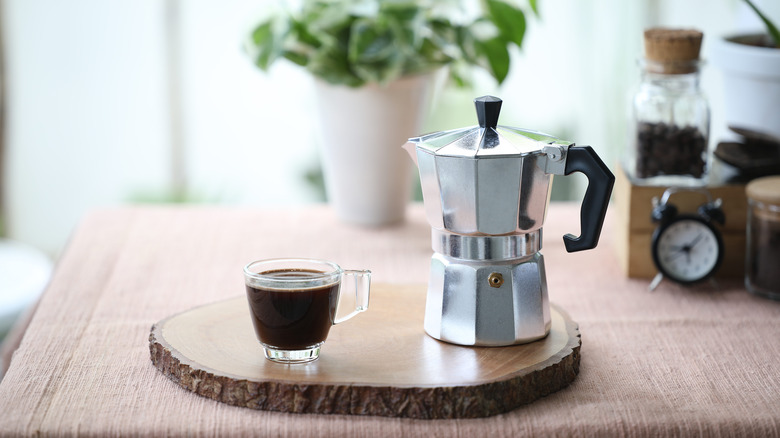The Moka Pot Water Tip That Leads To Better Tasting Coffee
There are some days when morning coffee needs a little extra strength. The usual drip coffee or even French press brew just isn't going to cut it, and the expertise of the local baristas isn't always an option. That means it's time to break out the moka pot. This stovetop coffee maker brews a robust cup of joe with a thick, creamy consistency very like espresso. If you haven't used one before, it's not hard to learn how a Moka coffee pot works — but it's worth the time to do it right.
There are a few secrets to better moka pot brewing, but if you really want to upgrade your morning coffee, it starts with the very first steps. Since Moka pot coffee is so strong, it can easily come out bitter if you're not careful. This bitterness is often derived from overheating and improper extraction of the coffee grounds by brewing with the incorrect water temperature. So instead of assembling your full moka pot with cold water and heating all the ingredients at the same time, heat the water first before you brew — and you'll find yourself with a cup of strong, flavorful coffee every time.
Brew without the bitterness
First, for clarity: a verbal diagram of the function of a Moka pot. The bottom chamber of the Moka pot is where the water goes; the funnel-shaped middle filter is for the coffee grounds. Rather than relying on gravity like drip coffee, the Moka pot brews through steam pressure — the steam from the water in the bottom chamber creates pressure that pushes the water through the coffee grounds, and the resulting coffee collects in the top chamber.
You can put all of these pieces of the Moka pot together then heat the water and brew the coffee at the same time — however, this will also heat the coffee grounds while you wait for the water to boil, which can cause the grounds to become bitter. As they sit submerged, coffee grounds will react even with the cold water and begin to lose flavor during this overly long extraction time, developing a sharp, disagreeable taste. Instead, heat your water with only the bottom portion on the stovetop. Once the water is boiled, assemble all of the pot parts (carefully, since the bottom chamber will be quite hot) and put everything back on the stove. As the steam pressure pushes the now-heated water up through the funnel filter, the coffee grounds will spend far less time heating and submerged — leading to a more agreeable flavor.
Brush up your moka pot skills
Water temperature is a crucial element of a proper Moka pot process, but it shouldn't be your only consideration to avoid brewing your coffee all wrong. Moka pots work best with a medium grind coffee (think the consistency of salt or sand), and even though Moka pots are often referred to as "stovetop espresso machines," you should never tamp your grounds as you would for an espresso machine. The Moka pot isn't built to create enough steam pressure to force the water through tightly packed coffee — and tamping can cause too much pressure build-up in the bottom chamber, leading the Moka pot to explode.
Now that you've avoided a morning coffee disaster, you can return to worrying about the flavor. Brew time is important, so when your coffee has collected in the upper chamber and you've heard the signature Moka gurgling sound, you'll want to immediately remove it from the heat and stop the brewing process. This can be accomplished by running the bottom of the pot under cold water or wrapping the pot in a cold towel — thus ceasing extraction and avoiding the over-brewed bitter taste. You'll be making cafe-quality coffee at home in no time.


